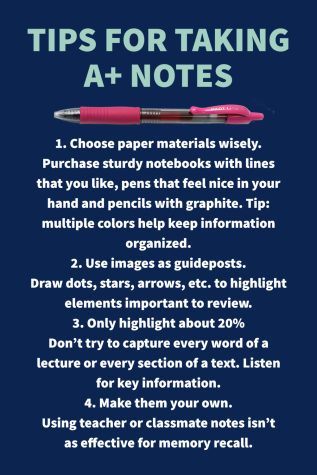Note-taking promotes productivity and creativity
Submitted Photo: Sophie Cullen
COLOR THEORY. Colors add aesthetic and make notes more efficient to read. Color coding is a popular way to organize content.
Verb tenses, vocabulary sets, variables: unless your mind is like a steel trap, the fine details fall through the cracks. But for those with minds like sieves, don’t despair—an intentional approach to taking notes helps people retain what they’ve learned while also adding an enjoyable aesthetic to things remembered.
Note-taking is a proven way to boost comprehension in class, but if notes contain more doodles than documentation, it may be time to reevaluate your methods. There are plenty of different ways to organize content, but the key is to keep the process engaging. But how?
Specialized materials are one way that note-taking can become more fun and active. Junior Sila Liljedahl uses Pilot G-2 pens, which she loves to break out when studying. “They’re like gel pens, but not overly watery… [They’re] really easy to write with, and they don’t smudge that easily,” she said.
Junior Lindsay Browne, on the other hand, switches up the way she writes.
“I use a lot of stars, inconsistent capitalization, pictures and drawings… [They] might look sort of random to other people, but since I am more of a visual learner, it helps me a lot,” she said.
Using non-standard symbols while writing keeps the brain active during the note-taking process, but they also help when reviewing; if the symbols act as guideposts, it’s easy to find important information.
Senior Sophie Cullen suggests paper note-taking for optimal engagement. “It’s a more active method of learning content,” she said, “and also helps me be more mindful when going over a subject than passively typing notes on a computer.”
Fans of physical notes aren’t without scientific backing. According to a study from 2010, writing things down on paper actually helps you to remember them better. The brain makes better connections and activates more when people put pen to paper, even when simply tracing letters.

Some students, however, prefer to take digital notes. There’s the classic type-in-a-Google-Doc method, but there are also apps for the iPad that allow for note-taking with a stylus. With a stylus, it’s possible to blend the productivity of a computer with the mental benefits of pen-and-paper writing. These apps, such as Goodnotes or Notability, can make keeping track of multiple subjects a breeze, and the content can be easily edited and rearranged.
An iPad or a computer is also much slimmer than a binder, but maybe not slimmer than a notebook, so bringing your notes to a café is simple and hassle-free.
In the end, whether digital or physical, purely pencil or multi-pen colorscape, notes are primarily a tool for their writer: “Notes don’t have to be super pretty or organized as long as you find a system that works for you,” Browne said.
My name is Eliza Farley (she/her). I work as the Opinions Editor for The Rubicon and as the Editor-in-Chief of Iris: Art + Lit. At school, I play tennis...
My name is Eliana Mann (she/her). I work as the Production Manager for The Rubicon online, and this is my fourth year on staff. At school, I’m a captain...